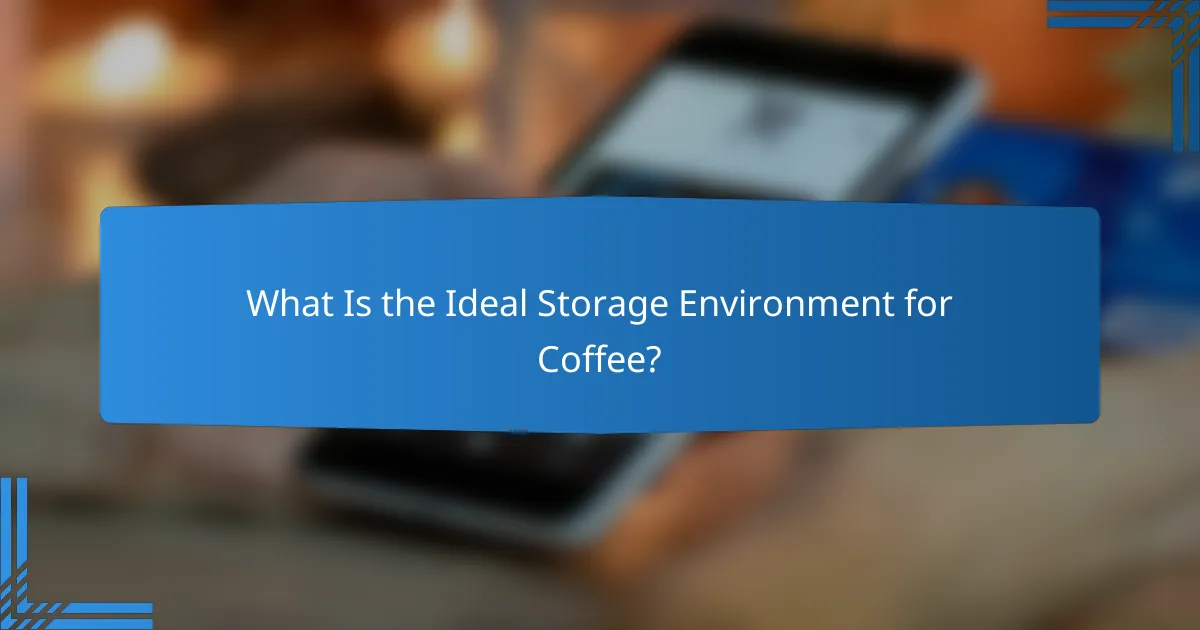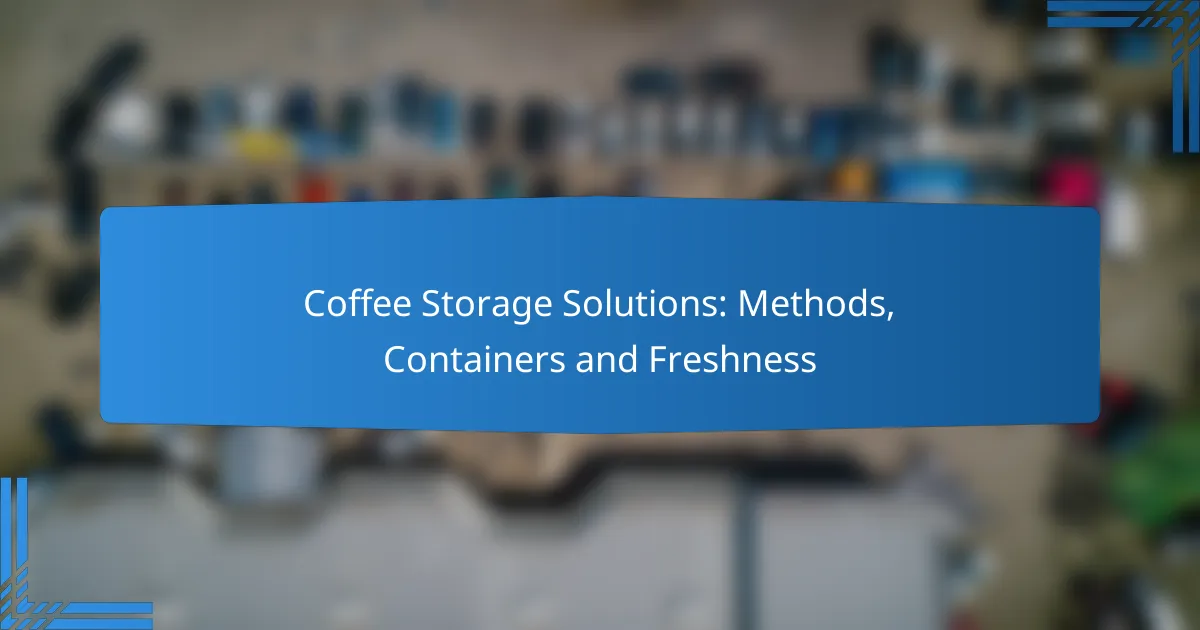Proper coffee storage is essential for preserving freshness and flavor, as it minimizes exposure to air, light, moisture, and heat. Selecting the right container can greatly extend the shelf life of your coffee, enhancing your brewing experience. By controlling the storage environment, including temperature and humidity, you can ensure that your coffee maintains its quality and taste over time.

What Are the Best Coffee Storage Solutions?
The best coffee storage solutions maintain freshness and flavor by minimizing exposure to air, light, moisture, and heat. Choosing the right container can significantly extend the shelf life of your coffee, ensuring a better brewing experience.
Airtight Containers
Airtight containers are designed to prevent air from entering, which helps to preserve the freshness of coffee beans or grounds. Look for options made from durable materials like plastic or glass with a secure sealing mechanism.
When using airtight containers, store them in a cool, dark place away from direct sunlight. Avoid frequent opening, as this can introduce moisture and air, leading to quicker degradation of the coffee’s flavor.
Vacuum Seal Bags
Vacuum seal bags remove air from the packaging, creating a tight seal that helps keep coffee fresh for longer periods. These bags are particularly useful for bulk storage, as they can significantly reduce oxidation.
To use vacuum seal bags effectively, ensure that the coffee is completely cooled before sealing. Store the bags in a cool, dark area, and consider using them for long-term storage, as they can last for months or even years when sealed properly.
Glass Jars
Glass jars are a popular choice for coffee storage due to their non-reactive nature and visibility. They can effectively keep coffee fresh if they have a tight-fitting lid that minimizes air exposure.
Choose dark or opaque glass jars to block light, which can degrade coffee quality over time. Regularly check for any signs of moisture or odor, and keep the jars in a cool, dry location to maintain optimal freshness.
Metal Canisters
Metal canisters provide a sturdy option for coffee storage, often featuring airtight seals. Stainless steel is a preferred material as it is durable and resistant to rust, making it suitable for long-term use.
When using metal canisters, ensure they are lined with a food-safe coating to prevent any metallic taste from affecting the coffee. Store them in a cool, dark place, and avoid exposing them to heat sources like stoves or ovens.
Silica Gel Packs
Silica gel packs are effective moisture absorbers that can help maintain the freshness of coffee by preventing excess humidity. Including them in your coffee storage solution can be particularly beneficial in humid climates.
Place silica gel packs in your airtight containers or jars, but ensure they do not come into direct contact with the coffee. Regularly check and replace them as needed to ensure they remain effective in keeping moisture at bay.

How Do Different Containers Affect Freshness?
The type of container used for coffee storage significantly impacts its freshness. Containers can either preserve or diminish the quality of coffee by affecting exposure to air, light, and moisture.
Material Impact
The material of a coffee container plays a crucial role in maintaining freshness. Glass, stainless steel, and ceramic are preferred materials as they are non-reactive and do not impart flavors. Plastic containers can be convenient but may allow air and moisture to penetrate, leading to quicker staleness.
When choosing a container, consider options with airtight seals to prevent oxidation. For example, vacuum-sealed containers are excellent for long-term storage, while simple jars with tight lids work well for short-term use.
Light Exposure
Light exposure can degrade coffee quality by causing chemical reactions that lead to flavor loss. Containers that are opaque or tinted help shield coffee from light, preserving its aromatic compounds. Clear glass containers should be kept in dark places to minimize exposure.
For optimal freshness, store coffee in a dark cabinet or pantry. Avoid placing containers on countertops where they may be exposed to sunlight, as even indirect light can affect the coffee over time.
Airflow Control
Controlling airflow is essential for maintaining coffee freshness. Containers that allow air to circulate can lead to oxidation, which diminishes flavor. Airtight containers are ideal as they limit airflow and keep coffee beans or grounds fresh for longer periods.
Consider using containers with one-way valves that allow gases to escape without letting air in. This is particularly useful for freshly roasted coffee, which releases carbon dioxide. Regularly check seals and lids to ensure they remain effective in preventing airflow.

What Is the Ideal Storage Environment for Coffee?
The ideal storage environment for coffee involves controlling temperature, humidity, and light exposure to maintain freshness and flavor. Proper conditions can significantly extend the shelf life of coffee beans and ground coffee, ensuring a better taste experience.
Temperature Recommendations
Storing coffee at a stable, cool temperature is crucial for preserving its quality. Ideally, coffee should be kept between 15°C and 25°C (59°F to 77°F). Avoid placing coffee near heat sources like ovens or direct sunlight, as higher temperatures can accelerate the degradation of flavor compounds.
For long-term storage, consider using a refrigerator or freezer, but ensure the coffee is in an airtight container to prevent moisture absorption and odor contamination. If using the freezer, only take out what you need to avoid repeated temperature fluctuations.
Humidity Levels
Humidity plays a significant role in coffee storage, with the ideal relative humidity being around 30% to 50%. High humidity can lead to mold growth and spoilage, while low humidity can cause the coffee to dry out and lose flavor. Always store coffee in a dry place away from moisture sources.
Using moisture-absorbing packets in your coffee storage container can help maintain optimal humidity levels. Avoid storing coffee in the kitchen if it is prone to steam and humidity from cooking.
Darkness and Light
Light exposure can negatively impact coffee freshness, causing it to lose flavor and aroma over time. Coffee should be stored in a dark place or in opaque containers that block light. Sunlight and even fluorescent light can lead to chemical reactions that degrade the coffee.
Consider using dark glass or ceramic containers for storage, as these materials provide excellent protection against light. Avoid clear plastic containers, as they allow light to penetrate and can contribute to faster deterioration of the coffee’s quality.

How Long Can Coffee Be Stored?
Coffee can be stored for varying lengths of time depending on its form and storage conditions. Whole beans generally last longer than ground coffee, but both require proper storage to maintain freshness.
Whole Bean Shelf Life
Whole beans can typically be stored for three to six months when kept in an airtight container in a cool, dark place. For optimal freshness, consider using a vacuum-sealed bag or a dedicated coffee canister.
After six months, the flavor and aroma of the beans may begin to degrade, although they may still be safe to consume. Always check for off smells or unusual appearances before brewing.
Ground Coffee Shelf Life
Ground coffee has a shorter shelf life, usually lasting about one to three months under similar storage conditions. Once ground, coffee is more susceptible to oxidation, which can lead to a stale taste.
To maximize freshness, store ground coffee in an airtight container and keep it away from light, heat, and moisture. If you notice a loss of flavor, it may be time to replace your coffee.
Factors Affecting Longevity
Additionally, the type of coffee bean and its roast level can play a role. Darker roasts tend to have a shorter shelf life due to their higher oil content. Always prioritize proper storage techniques to extend the life of your coffee.

What Are the Common Mistakes in Coffee Storage?
Common mistakes in coffee storage can significantly impact the freshness and flavor of your coffee. Key errors include using non-airtight containers, storing coffee in the fridge, and exposing it to air.
Using Non-Airtight Containers
Non-airtight containers allow air to seep in, which can lead to oxidation and loss of flavor. Ideal storage containers should be airtight to keep moisture and air out, preserving the coffee’s freshness for longer.
Consider using glass jars with tight-sealing lids, vacuum-sealed bags, or specialized coffee canisters. Avoid using standard plastic containers, as they often do not provide a proper seal.
Storing in the Fridge
Storing coffee in the fridge is a common mistake that can lead to stale flavors. The fluctuating temperatures and moisture in the fridge can negatively affect the coffee’s quality.
Instead, store coffee in a cool, dark place at room temperature, away from light and heat sources. A pantry or cupboard is usually a better option than the refrigerator.
Exposing to Air
Exposing coffee to air can cause it to lose its aroma and flavor quickly. Oxygen interacts with the oils in coffee, leading to rancidity and a flat taste.
To minimize air exposure, only open your coffee container when necessary and reseal it immediately. Consider using a one-way valve bag for storage, which allows gases to escape without letting air in.
